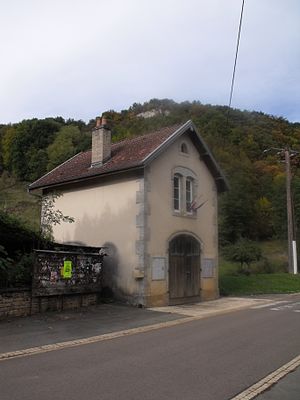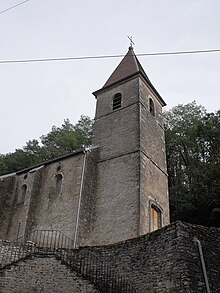Rognon (Doubs)
| Rognon | ||
|---|---|---|
|
|
||
| region | Bourgogne-Franche-Comté | |
| Department | Doubs | |
| Arrondissement | Besançon | |
| Canton | Baume-les-Dames | |
| Community association | Deux Vallées Vertes | |
| Coordinates | 47 ° 25 ′ N , 6 ° 19 ′ E | |
| height | 259-445 m | |
| surface | 4.09 km 2 | |
| Residents | 48 (January 1, 2017) | |
| Population density | 12 inhabitants / km 2 | |
| Post Code | 25680 | |
| INSEE code | 25498 | |
 Mairie Rognon |
||
Rognon is a French commune with a population of 48 (as at 1st January 2017) in the Doubs department in the region of Bourgogne Franche-Comté .
geography
Rognon is located at 280 m , nine kilometers north-northwest of Baume-les-Dames and about 30 kilometers northeast of the city of Besançon (as the crow flies). The village extends in the undulating landscape between the river valleys of Doubs in the south and Ognon in the north, in the valley of the Crenu at the north foot of the Bois du Rocher.
The area of the 4.09 km² municipal area covers a section of the undulating landscape between the Doubs and Ognon. The central part of the area is taken up by the valley of the Crenu , which has a flat valley low about 200 to 500 m wide and provides drainage to the west to the Ognon. The valley is flanked in the north by the heights of the Grand Bois (up to 380 m). To the south, the community area extends over a relatively steep slope to the wide, wooded ridge of the Bois du Rocher , on which the highest elevation of Rognon is reached at 445 m. In the south-east the communal soil extends into the valley of the Rupt de Vaulx, a southern side valley of the Crenu.
Neighboring communities of Rognon are Montussaint and Puessans in the north, Tournans in the east and south and Tallans in the west.
history
Rognon is mentioned for the first time in 1166. In the Middle Ages the village belonged to the lordship of Montmartin. Together with Franche-Comté , it finally came to France with the Peace of Nijmegen in 1678. Today Rognon is part of the Deux Vallées Vertes municipal association .
Attractions
On the slope above the village stands the Saint-Nicolas church, which was built around 1700 on the site of a medieval chapel. Remains of a medieval castle are visible. In the center there are numerous houses in the characteristic style of Franche-Comté from the 17th to 19th centuries.
population
| Population development | |
|---|---|
| year | Residents |
| 1962 | 40 |
| 1968 | 45 |
| 1975 | 56 |
| 1982 | 70 |
| 1990 | 55 |
| 1999 | 44 |
| 2016 | 49 |
With 48 inhabitants (as of January 1, 2017), Rognon is one of the smallest communities in the Doubs department. After the population had decreased significantly in the first half of the 20th century (187 people were still counted in 1881), only relatively minor fluctuations have been recorded since the early 1960s.
Economy and Infrastructure
Until well into the 20th century, Rognon was primarily a village characterized by agriculture (arable farming, fruit growing and cattle breeding) and forestry. Even today, the residents live mainly from their work in the first sector. Outside the primary sector there are few jobs in the village. Some workers are also commuters who work in the surrounding larger towns.
The village is off the major thoroughfares on a departmental road that leads from Clerval to Avilley . The closest connection to the A36 motorway is around twelve kilometers away. Another road connection exists with Tournans.
literature
- Le Patrimoine des Communes du Doubs. Volume 2, Flohic Editions, Paris 2001, ISBN 2-84234-087-6 , p. 1121.

